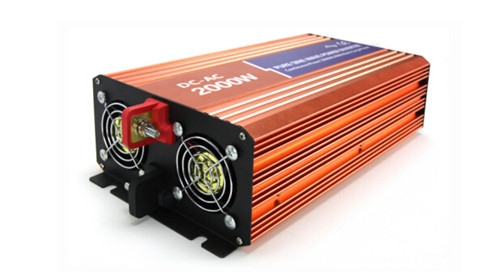Inverters convert DC energy (batteries, storage batteries) into AC (typically 220V, 50Hz sine wave). It consists of an inverter bridge, control logic, and filter circuits. Widely used in air conditioning, home theater, electric grinding wheel, electric tools, sewing machines, DVD, VCD, computers, televisions, washing machines, range hoods, refrigerators, video recorders, massagers, fans, lighting and so on. Next Xiaobian introduced the working principle of the inverter and the role of the inverter.

How does the inverter work?
The inverter is a DC to AC transformer. In fact, the converter is a voltage inversion process. The converter is to convert the AC voltage of the power grid into a stable 12V DC output, and the inverter is to convert the 12V DC voltage output by the Adapter to a high-frequency AC voltage; the same applies to the pulse widths used in both parts. Modulation (PWM) technology. The core part is a PWM integrated controller, Adapter UC3842, inverter uses TL5001 chip. TL5001 operating voltage range 3.6 ~ 40V, its internal error amplifier, a regulator, oscillator, PWM control with dead-zone control, low-voltage protection circuit and short circuit protection circuit.
Input interface part: Input part has 3 signals, 12V DC input VIN, working enable voltage ENB and Panel current control signal DIM. VIN is provided by the Adapter. The ENB voltage is provided by the MCU on the motherboard. The value is 0 or 3V. When ENB=0, the inverter does not work, while at ENB=3V, the inverter is in normal operation; and the DIM voltage Provided by the mainboard, the change range is between 0 and 5V. Different DIM values ​​are fed back to the feedback end of the PWM controller. The current provided by the inverter to the load will also be different. The smaller the DIM value, the lower the output current of the inverter. The bigger it is.
Voltage start circuit: When ENB is high, the output voltage is high to light the backlight of the Panel.
PWM controller: It has the following functions: internal reference voltage, error amplifier, oscillator and PWM, overvoltage protection, undervoltage protection, short circuit protection, and output transistor.
DC conversion: The MOS switch and energy storage inductors form a voltage conversion circuit. After the input pulse is amplified by the push-pull amplifier, it drives the MOS tube to perform the switching action, so that the DC voltage charges and discharges the inductor, so that the other end of the inductor can be exchanged. Voltage.
LC Oscillation and Output Circuit: The 1600V voltage required for starting the lamp is controlled, and the voltage is reduced to 800V after the lamp is started.
Output voltage feedback: When the load is working, the sampled voltage is fed back to stabilize the I-inverter voltage output.

The role of the inverter
1. Maximum power tracking function to ensure maximum output power
The current and voltage of the solar panel vary with the solar radiation intensity and the temperature of the solar cell module itself. Therefore, the output power also changes. To maximize the output power, the maximum output power of the panel must be obtained as much as possible. The MPPT tracking function of the inverter is designed for this feature. MPPT tracking is also called maximum power point tracking. It is estimated that a system configured with MPPT tracking can generate 50% more power than a system without MPPT tracking. Therefore, if you want a photovoltaic system to generate more electricity, don't just look at the solar panel. How much of the electricity generated by the solar panel can be effectively output, or whether it depends on the inverter.
2, anti-separation operation function to protect the safety of the power grid
Many people in the installation of photovoltaic systems hold the idea that even if the power grid loses power, their homes can also use their own power, and everyone knows that when the power grid fails, their own photovoltaic systems will stop operating. The reason for this phenomenon is that Inverters are generally equipped with anti-islanding devices, and when the grid voltage is 0, the inverter will stop working.Are there any kind of pit feeling when you hear this? Don't worry, listen to me explain it to you. The island device is an essential device for all photovoltaic grid-connected inverters. The reason why this is done is mainly for the consideration of grid security. Imagine that the grid is out of power and the grid staff has taken over the circuit to repair the circuit and your home’s photovoltaic system. There is also a steady stream of power... It's easy to cause a security incident.
3, according to the solar panel output power, automatic operation and shutdown
After sunrise in the morning, the solar radiation intensity gradually increases, and the output of the solar cell also increases. When the output power required by the inverter is reached, the inverter automatically starts operating. After entering the operation, the inverter constantly monitors the output of the solar cell module. As long as the output power of the solar cell module is greater than the output power required by the inverter, the inverter will continue to operate; until sunset, even if it is overcast, The inverter can also operate. When the output of the solar cell module becomes smaller and the output of the inverter approaches zero, the inverter forms a standby state.
Editor's summary: The working principle of the inverter and the role of the inverter are introduced here, and we hope to help everyone. If you want to know more related information, you can pay attention to this website information.
Siphon principle principle of refrigeration
Coating Additives, Textile Dyes, Plastics Pigment
Dynasty Chemicals (NingBo) Co., Ltd. , https://www.dychemco.com